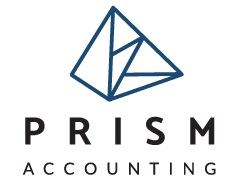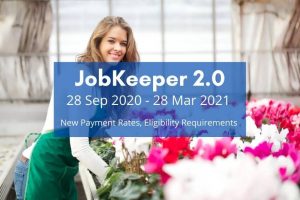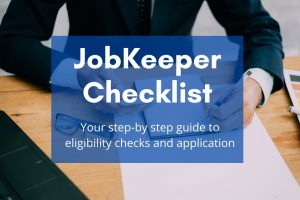Download JobKeeper Checklist to assist you through the process of checking your eligibility and applying for JobKeeper payments
If your business is significantly impacted by Coronavirus, you may be eligible to receive JobKeeper payment of $1,500 per eligible worker.
To qualify, your business must meet eligibility criteria and have, or be likely have, a substantial decline in turnover in a relevant period.
The decline, expressed as a percentage, must be at least
- 30% for businesses with an aggregated turnover of $1 billion or less
- 50% for businesses with an aggregated turnover over $1 billion
- 15% for ACNC registered charities other than universities and schools
Entities Eligible for JobKeeper Scheme
An entity qualifies for the JobKeeper payments if:
- on 1 March 2020, it carried on a business in Australia, or was a non‑profit body that pursued its objectives principally in Australia; and
- had at least one eligible employee or a business participant
- satisfied a decline in turnover test
Ineligible entities:
- entities subject to the Major Bank Levy
- government bodies
- companies in liquidation
- individuals in bankruptcy
Timing of JobKeeper Scheme
JobKeeper Scheme operates from 30 March 2020 to 27 September 2020 (maximum of 26 weeks).
Payments are to be made for fortnightly periods, with the first fortnight starting on Monday, 30 March 2020, and the last fortnight ending on 27 September 2020
JobKeeper Entitlement Based on Paid Employees
Payments will be made for each eligible employee, including full-time, part-time, and long term casuals who do not have a permanent employment elsewhere
Eligibility of employees is assessed for each fortnight for which JobKeeper payments are intended to be claimed.
Eligible employees
An individual is an eligible employee if
- the individual is employed by the entity at any time in the fortnight;
- on 1 March 2020, was aged 16 or over
- as at 1 March 2020, was either a permanent full-time or part-time employee, or a long term casual employee (employed on a regular and systematic basis for at least 12 months) not employed on a permanent basis by another entity
- as at 1 March 2020, was an Australian resident or a holder a Subclass 444 visa.
- satisfies nomination requirements
- is not being paid parental leave or dad and partner pay;
- is not totally incapacitated for work where workers compensation is payable
A person who has been stood down or is on leave is considered to be an employee and may be an eligible employee for JobKeeper payment purposes.
Employees who were terminated after 1 March 2020 and later re-engaged can qualify for JobKeeper payment from the fortnight they were re-engaged provided they met the eligibility criteria on 1 March 2020.
Nomination Requirements for Employees
Before you can claim JobKeeper payment, you need to notify each eligible employee of your intent to nominate them as eligible employees, and they must agree to be nominated by you by completing the JobKeeper employee nomination notice in the approved form. The form can be downloaded from the ATO website.
Download JobKeeper employee nomination notice (PDF 188KB) or JobKeeper employee nomination notice (DOCX 67KB) accessible format.
By completing the ATO nomination notice, employees effectively make a statement that:
- they satisfy eligibility requirements
- they agree to be nominated by the entity as an eligible employee of the entity for the purposes of the JobKeeper Scheme
The nomination form does not need to be sent to the ATO however it must be kept by employers for record-keeping purposes as required under the law.
The same individual cannot be nominated by more than one entity. If an overpayment results from an individual nominating with more than one entity, the individual may be jointly and severally liable to pay the overpayment and any general interest charge on the overpayment.
“One in, all in” principle applies
The employer must ensure that all of these eligible employees who agreed to be nominated are covered by their participation in the scheme. This includes all eligible employees who have been stood down. The employer cannot select which eligible employees will participate in the scheme but employees can decline to be nominated.
Wage Condition
It is important to note that JobKeeper payments will be paid by way of reimbursement.
You must pay your participating employees at least $1,500 (before tax) for each fortnight for which you intend to claim JobKeeper payments before you can be eligible for reimbursements. That means, if some your employees are ordinarily paid less, you will be required to pay gross amount of $1500 per fortnight to qualify. If you do not continue to pay your employees for each pay period, you will cease to qualify for the JobKeeper payment.
Amounts covered by $1,500 minimum include:
- salary, wages, commissions, bonuses or allowances
- amounts of PAYG withholdings from the payments
- super contributions under a salary sacrifice arrangement paid in the fortnight to a super fund for the benefits of the employee
- other amounts applied under salary sacrifice arrangements
If an employee ordinarily receives less than $1500 per fortnight, you are required to pay super contribution based on the amount paid for working their ordinary hours, disregarding any top up amounts made for the purpose of satisfying wage condition for JobKeeper payment.
JobKeeper payments can be made for the period beginning 30 March 2020.
For the first two fortnights (30 March – 12 April and 13 April – 26 April), the ATO will accept late payment of the minimum $1,500, provided it is paid by the end of April. This means that you can make two fortnightly payments of at least $1,500 per fortnight before the end of April, or a combined payment of at least $3,000 before the end of April.
JobKeeper payments will start to be paid to eligible employers in the first week of May 2020.
JobKeeper Entitlement Based on Business Participation (Sole Traders and Other Entities)
JobKeeper Scheme also extends to individuals who are not employees but who are actively participating in business. The entity must not be a non-for profit entity for the purpose of this entitlement.
The following individuals can qualify as business participants for JobKeeper payments:
- a sole trader
- a partner in a partnership (one per entity)
- an adult beneficiary in a trust (one per entity)
- a director or a shareholder of the company (one per entity)
JobKeeper payments are limited to one non-employee business participant per entity. Entities must choose which individual to nominate.
The Rules stipulate that an entity is not entitled to claim JobKeeper payment for more than individual based on business participation, whether for the same of for a different fortnight. That means, the entity cannot change the nominated individual once the it becomes entitled to payments in respect of that individual.
Eligible business participant
An individual is an eligible business participant for an entity if the individual:
- is actively engaged in the business
- was not employed by the entity at any time in the fortnight
- on 1 March 2020, was aged 16 or over
- as at 1 March 2020, was an Australian resident or a holder a Subclass 444 visa.
- satisfies nomination requirements
- is not being paid parental leave or dad and partner pay
- is not totally incapacitated for work where workers compensation is payable
If the individual agrees to be nominated by the entity for JobKeeper payment, he or she must provide a nomination notice in the approved form to the entity. If the individual is a sole trader, the notice must be provided to the Commissioner.
Nomination requirements for business participants are different to the employees. The nomination notice must state that the individual agrees to be nominated as a business participant and satisfied the eligibility requirements. At the time the individual gives the entity the nomination notice, he or she must not be a permanent employee of another entity, and must not have agreed to be nominated as a business participant by another entity or as a sole trader.
JobKeeper nomination notice – entities other than sole traders
Download the JobKeeper nomination notice for eligible business participants – excluding sole traders (PDF179KB)
This notice is also available in an accessible format, JobKeeper nomination notice for eligible business participants – excluding sole traders (DOCX 58.4KB)
You do not need to send the notice to the ATO but must keep it for your record-keeping purposes.
JobKeeper nomination notice – sole traders
If you are a sole trader nominating yourself, you will complete nomination during your enrolment process. It can be done by you or your Registered Tax Agent.
You need to log in to ATO online services via myGov or the Business Portal using myGovID.
Enroll and nominate by confirming:
- your business has experienced a fall in turnover of at least 30%
- expected number of eligible employees (if you have them)
- your bank and contact details for payment
- you are a sole trader nominating as an eligible business participant.
Note, if you have employees, you will need them to complete employee nomination notices separately.
Integrity Rules
In addition to general eligibility criteria, entities seeking to apply for JobKeeper payments in relation to a business participant must also satisfy the Integrity Rules. This is to ensure the payments are available to active businesses only.
It is required that the entity:
- had an ABN on 12 March 2020
- had assessable income from business activity in 2018 – 2019 income year OR made a supply in 1 July 2018 – 12 March 2020 period, and provided notice to the Commissioner on or before 12 March 2020
Commissioner can exercise a discretion to allow these requirements to be satisfied at a later time. Discretion will be available in limited circumstances.
Turnover Test
The entity must satisfy the Turnover Test before it can be eligible for JobKeeper Payment.
Basic Turnover Test
In most circumstances, businesses will use the basic test. To apply the test, you need to compare your projected GST turnover in a test period with your GST turnover in a comparison period (same period in the last year).
You can choose a test period to be one month or one quarter, regardless of whether you report quarterly or monthly.
Monthly periods
For qualification from the start of the scheme, the test month can be either March 2020 or April 2020.
You can qualify at a later time by testing turnover for May, June, July, August or September 2020
Quarterly periods
For quarterly comparisons, the test period must be:
– 1 April – 30 June 2020 (to qualify from start date of the scheme)
– 1 July – 30 September 2020 (to qualify at a later time).
For turnover test, you must compare actual or projected GST Turnover for the test period with the GST Turnover in a comparison period (e.g. April 2020 vs April 2019). Then, you need to work out if the shortfall exceeds the relevant percentage (generally, 30%).
If the test is failed in one period, the entity can re-test again in a later period. Once you satisfy the decline in turnover test, you do not have to re-test again.
For calculating a projected GST turnover you need to include value of the sales you are likely to make for the period,on the balance of probabilities (i.e. more likely than not).
Do not include the following amounts in your calculation:
- input tax sales (e.g. as residential rent)
- payments not connected with carrying on an enterprise (e.g. sale of private assets by a sole trader)
- transfers of capital assets
- sale of assets as a consequence of substantially and permanently reducing in size or scale the enterprise
Alternative Turnover Test
The ATO issued Alternative Decline in Turnover Test Rules to to a class of entities where there is no appropriate relevant comparison period for calculating decline in turnover (e.g. if an entity did not trade in the previous year, or if trading was impacted by some out of ordinary event).
The test applies in the following circumstances:
- The entity commenced business before 1 March 2020 but after the relevant comparison period.
- There was an acquisition or disposal that changed the entity turnover
- There was a business restructure that changed the entity’s turnover
- The entity has substantial increase in turnover of:
- 50% or more in the 12 months immediately before the applicable turnover test period, or
- 25% or more in the 6 months immediately before the applicable turnover test period, or
- 12.5% or more in the 3 months immediately before the applicable turnover test period.
- The entity was conducting business in a declared drought or natural disaster zone in the comparison period, and the turnover was affected by drought or natural disaster
- The entity has an an irregular turnover with over 50% of variance in the turnover.
- The entity was a sole trader or a partnership with no employees and the turnover was affected by sickness, injury or leave in the comparison period.
You can get more information on these alternative tests in the Legislative Instrument and Explanatory Statement:
- Coronavirus Economic Response Package (Payments and Benefits) Alternative Decline in Turnover Test Rules 2020
- Explanatory statement: Coronavirus Economic Response Package (Payments and Benefits) Alternative Decline in Turnover Test Rules 2020
If you satisfy Basic Test, you do not have to apply Alternative Test.
Application Process
To apply for JobKeeper Payment, you must follow the application process prescribed by the ATO. The information is regularly updated
Enrolment for JobKeeper payment is available from 20 April 2020.
You will be able to submit your claim from 4 May 2020 .
You will need access to online Business Portal in order to submit your application, which required MyGovID (this is different to myGov Registration). Your Registered Tax Agent will also be able to apply on your behalf.
ATO JobKeeper Payments Guides
The ATO released JobKeeper Guides to provide practical step-by-step guide though the application process::
- JobKeeper guide – sole traders – a practical step-by-step guide for sole traders.
- JobKeeper guide – employers reporting through STP – a practical step-by-step guide for employers reporting through STP.
- JobKeeper guide – employers not reporting through STP – a practical step-by-step guide for employers not reporting through STP.
Monthly reporting
An entity that is entitled to a JobKeeper payment for a fortnight must report to the ATO in the approved form on a monthly basis:
- its current GST turnover for the reporting month; and
- its projected GST turnover for the following month.
The reporting month is a month that includes a period in a fortnight for which the entity is entitled to a JobKeeper payment. The report must be lodged within 7 days of the end of the reporting month.
The turnover information provided in the report will affect an entity’s eligibility once decline in turnover test has been satisfied. You only need to satisfy the test once.
Extension of JobKeeper Payments (21 July 2020 Update)
On 21 July 2020, the Government announced it will be extending JobKeeper Payments from 28 September until 28 March 2021. The extended JobKeeper program will continue to operate post 27 September in a modified form to support those businesses who continue to be significantly impacted by the Coronavirus.
For more information, see Covid-19: JobKeeper 2.0 – New Rates, Eligibility Rules
Need Help?
If you need assistance with checking eligibility, application process and reporting for JobKeeper Payments, we are able to help! Send us an enquiry or call our office to see how we can help.
JobKeeper Resources:
For more information about JobKeeper payments as part of Economic Response to COVID-19 (Coronavirus) Federal Government Stimulus Package, check the links below:
- JobKeeper Rules (Coronavirus Economic Response Package (Payments and Benefits) Rules 2020)
- JobKeeper Explanatory Statement
- ATO JobKeeper Payments information
- Treasury Fact Sheets:
- ATO JobKeeper Guides:
- JobKeeper guide – sole traders – a practical step-by-step guide for sole traders.
- JobKeeper guide – employers reporting through STP – a practical step-by-step guide for employers reporting through STP.
- JobKeeper guide – employers not reporting through STP – a practical step-by-step guide for employers not reporting through STP.
- Alternative Turnover Test:
- Treasurer’s Media Releases
Disclaimer: All the information provided on this website is of general nature and does not constitute tax, legal or financial advice. It does not take into account your personal circumstances and is not intended to replace consultation with a qualified professional.






